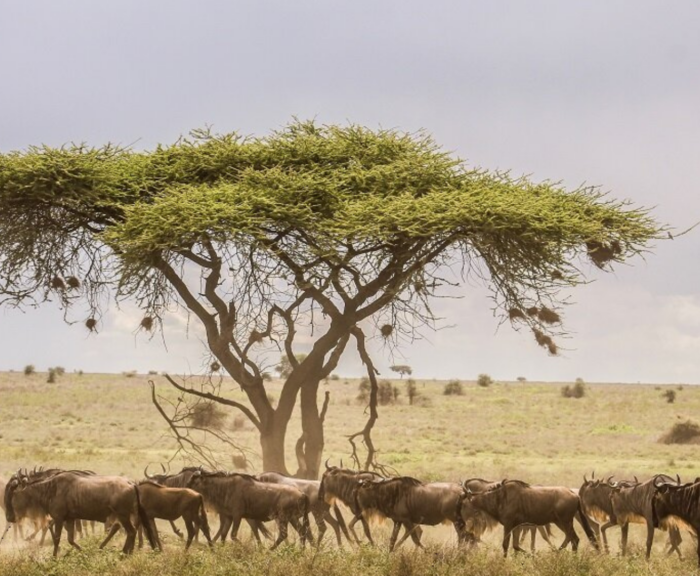**Best Time to Visit East Africa for Unforgettable Experiences** Are you planning a trip to East Africa but unsure when to go? This guide explores the optimal times to visit destinations like Mozambique and Victoria Falls, ensuring you experience Arusha and Tarangire National Park at their best. Additionally, it provides essential travel tips, such as selecting the right insect repellent. By choosing the right time to visit, you’ll maximize your adventures and create lasting memories without common travel hassles.
Best Time to Visit East Africa for Unforgettable Experiences
Understanding East Africa‘s seasons is key to unforgettable experiences. Yearly wildlife events, such as Mara River migrations and whale sightings near Burundi, occur at different times. Evaluating weather patterns helps avoid floods and plan activities like Mount Kilimanjaro climbs. Identifying peak tourist periods and ideal months ensures optimal travel conditions.
Understanding Seasonal Changes in East Africa
Seasonal variations across East Africa influence the best times to visit key destinations such as Botswana, Murchison Falls National Park, and Lake Victoria. The Great Migration, for example, reaches its peak during the dry season, providing exceptional opportunities for wildlife observation. Additionally, understanding the climate in the Republic of the Congo is essential for planning activities and ensuring a memorable travel experience.
Identifying Unique Wildlife Events Throughout the Year
Throughout the year, East Africa showcases a variety of unique wildlife events that captivate visitors. Lake Nakuru, for example, becomes a haven for flamingos during specific seasons, creating breathtaking landscapes ideal for photography enthusiasts. Travelers can enhance their experience by staying in accommodations with well-appointed bedrooms and modern bathrooms, ensuring comfort while enjoying the region’s diverse climate and vibrant wildlife.
Exploring Weather Patterns and Their Impact on Travel
Weather patterns in East Africa significantly influence travel plans, as regions like Mount Kenya experience distinct rainy and dry seasons that affect climbing conditions and accessibility. Travelers migrating from West Africa to explore areas such as Virunga National Park must account for these climatic changes to ensure seamless immigration processes and optimal wildlife viewing opportunities. Additionally, sandy landscapes across East Africa can vary with the seasons, emphasizing the importance of understanding weather trends for a memorable journey.
Analyzing Peak Tourist Seasons in East Africa
The peak tourist seasons in East Africa offer the best opportunities to experience the beauty of iconic destinations such as Amboseli National Park and Bwindi Impenetrable Forest. Visiting during these times ensures favorable weather and abundant wildlife sightings, attracting travelers from regions like South Sudan and even distant locations like Cape Town. Aligning travel plans with these prime periods allows visitors to fully enjoy East Africa’s renowned landscapes and vibrant culture.
Recommended Months for Adventure Activities in East Africa
The months from June to October are ideal for adventure activities in East Africa, offering optimal conditions for exploring the Ngorongoro Conservation Area and trekking in Mgahinga Gorilla National Park, both recognized as World Heritage Sites. During this period, wildlife sightings are abundant, allowing enthusiasts to observe a diverse range of species. Additionally, the dry season along the Indian Ocean coast provides perfect weather for water-based adventures and beach excursions, enhancing the overall travel experience.
Best Time of Year to Experience the Great Migration
Best time of year to experience the Great Migration involves tracking the migration patterns across the Serengeti. Safari enthusiasts can find optimal viewing locations, such as Queen Elizabeth National Park and the Garden Route area. Key factors like seasonal rainfall and historical events, including genocide, influence migration timing and experience. Unique experiences along the migration route, including rainforest segments, offer memorable moments for travelers from North America.
Tracking the Migration Patterns Across the Serengeti
Tracking the migration patterns across the Serengeti involves observing the herd‘s movements through key areas like Lake Manyara National Park and nearby villages. This detailed understanding assists travelers in identifying the best time to visit east africa, ensuring they experience the peak of the Great Migration while also having the opportunity to explore attractions such as Bwindi Impenetrable National Park.
Optimal Viewing Locations for Safari Enthusiasts
Serengeti National Park’s expansive grasslands offer premier locations for safari enthusiasts to witness the Great Migration, where vast herds traverse the plains in a mesmerizing display. Nearby, the vibrant city of Mombasa provides convenient access for international travelers, including those from the Middle East, enhancing their birdwatching experiences with diverse avian species. Additionally, parks equipped with excellent nursing facilities ensure that both wildlife and visitors receive necessary care, making these destinations ideal for a comprehensive and memorable safari adventure.
Key Factors Influencing Migration Timing and Experience
The timing and quality of the Great Migration are shaped by seasonal rains and the movement of grazing herds within the Serengeti game reserve. These factors not only dictate the best periods for witnessing large herds but also enhance opportunities for unique experiences, such as hot air balloon rides over migration routes and sightings of species like rhinoceros and golden monkeys. Additionally, international visitors, including those from Arab nations, often align their travel plans with these natural cycles to maximize their safari experiences.
Unique Experiences Along the Migration Route
Along the migration route, travelers can witness impalas gracefully navigating the expansive plains while the persistent wind adds a dynamic element to the landscape, enhancing wildlife sightings. Visiting nearby Volcanoes National Park offers a distinct experience with its rugged terrain and diverse species, complementing the migration adventure. Additionally, those journeying from North Africa may choose to extend their safari to Kruger National Park, enriching their exploration of Africa’s remarkable ecosystems.
Hidden Gems to Visit During Off-Peak Seasons
Exploring East Africa during off-peak seasons allows travelers to visit lesser-known destinations like Djibouti and Nyungwe Forest. Shoulder periods, often marked by monsoon showers, offer better value and easier access to coastal areas. Unique cultural experiences are available year-round, ensuring enriching visits without the typical tourist crowds.
Discovering Lesser-Known Destinations in East Africa
Among East Africa’s hidden treasures, Kigali stands out with its stunning landscape and vibrant culture, offering travelers a peaceful alternative to crowded areas like the Maasai Mara. The city benefits from moderate humidity, making it an ideal destination during off-peak seasons. As a key member of the East African Community, Kigali provides unique cultural experiences and easy access to neighboring lesser-known regions, ensuring visitors enjoy a rich and authentic East African adventure.
Benefits of Traveling During Shoulder Seasons
Traveling during shoulder seasons offers significant advantages for those embarking on an East African safari, as it allows visitors to experience vibrant wildlife encounters with mountain gorillas and chimpanzees without the crowds found in peak times. In Nairobi and other regions of Southern Africa, the milder weather ensures comfortable exploration while also providing better value for accommodations and tours. Additionally, shoulder seasons present unique opportunities to engage with local communities, enhancing the overall travel experience with authentic cultural interactions.
Unique Cultural Experiences Available Year-Round
Throughout the dry season, visitors can immerse themselves in authentic cultural events, enjoying traditional music and crafts with ease thanks to efficient transport services. Accommodations often provide essential amenities like hair dryers, ensuring comfort during stays. Supportive tourism policies facilitate meaningful interactions with local communities, and the chance to observe cheetahs in nearby areas enhances the overall cultural experience, making off-peak travel both enriching and convenient.
Value and Accessibility in Off-Peak Travel
Travelers who choose to visit Uganda during off-peak seasons can explore its rich jungles and the breathtaking Okavango Delta with greater ease and affordability. This strategic timing not only enhances accessibility to key attractions but also allows visitors to immerse themselves in wildlife experiences reminiscent of The Lion King, drawing parallels to the vibrant ecosystems found in Southeast Asia.
Best Weather Conditions for Outdoor Activities
East Africa‘s weather patterns guide the best times for outdoor activities, from hiking Mount Kilimanjaro during dry months to beach relaxation outside the wet season. Safari planning considers climatic conditions to spot endangered species like hyenas in Kibale National Park. Additionally, photographers, including those from Sudan, can leverage seasonal changes for optimal captures.
Ideal Months for Hiking Mount Kilimanjaro
The best time of year to visit East Africa for hiking Mount Kilimanjaro is during the dry seasons from January to March and June to October, when trails are more accessible and views of nearby Serengeti‘s vast landscapes and serene lakes are at their peak. Climbers often enjoy stunning vistas from their hotel balconies as they prepare for the ascent, and the region’s diverse primate species add an extra layer of fascination to the overall experience.
Optimal Conditions for Beach Visits and Relaxation
For beach enthusiasts, the optimal time to visit East Africa is during the dry season when tourism thrives with clear skies and calm waters. Coastal areas near the Virunga Mountains offer serene settings where visitors can relax on pristine beaches while enjoying sightings of gazelles and diverse wildlife. Engaging with the Maasai people nearby provides an enriching cultural experience, enhancing the overall beach relaxation with a unique blend of natural beauty and local traditions.
Planning Safaris Based on Climatic Patterns
Effective planning of safaris in East Africa hinges on understanding climatic patterns, which directly influence vegetation growth and wildlife movements, including antelope herds near the Nile. During the dry season, lush vegetation thins, making it easier to spot animals against the sparse landscape, while in regions like Rwanda, seasonal rains shape the availability of water sources and grazing areas. Additionally, having a basic knowledge of the Swahili language can enhance interactions with local guides, ensuring a more insightful and seamless safari experience. By aligning travel schedules with these climatic insights, visitors can maximize their chances of witnessing diverse wildlife and thriving ecosystems.
Seasonal Considerations for Photography Enthusiasts
Photographers visiting East Africa should consider the dry season for optimal wildlife and landscape shots, as locations like the Sheldrick Wildlife Trust and Katavi National Park in Tanzania offer clearer views and vibrant contrasts. Exploring areas such as Dar es Salaam and neighboring Zimbabwe during this time allows for capturing the rich local culture and stunning natural landmarks with minimal rainfall interruptions. Additionally, favorable lighting conditions enhance the quality of photographs, making it the ideal period for enthusiasts to document their unforgettable experiences.
Cultural Festivals and Events to Experience in East Africa
East Africa hosts major festivals across the Great Rift Valley, Nairobi National Park, and Chobe National Park, showcasing vibrant local celebrations and traditions. Participating in events near destinations like Olduvai Gorge and observing mountain gorillas enhances travel experiences. These cultural immersion opportunities provide travelers with authentic insights and unforgettable memories, aligning with various festivals’ timings throughout the region.
Major Festivals and Their Timing in East Africa
Major festivals in East Africa, such as the vibrant Mombasa Carnival and Kigali’s Umuganura Harvest Festival, are timed to coincide with specific seasons, providing travelers with rich cultural experiences alongside visits to attractions like Etosha National Park. The region’s improving infrastructure ensures that visitors can easily attend these events without the hassle of excessive baggage, even in areas like Somalia. These celebrations highlight the diverse traditions of East Africa, making them essential additions to any travel itinerary during peak festival times.
Participating in Local Celebrations and Traditions
Visitors to East Africa, particularly during Zambia‘s shoulder seasons, can immerse themselves in local customs and celebrations, such as vibrant festivals near Akagera National Park. These events provide an authentic glimpse into the region’s cultural heritage while travelers have the opportunity to observe wildlife, including hippopotamus, in their natural habitats. Engaging with these traditions enhances the overall travel experience, offering a harmonious blend of cultural enrichment and natural beauty.
Enhancing Your Trip With Cultural Immersion Opportunities
Enhancing a trip with cultural immersion opportunities in East Africa allows travelers to engage deeply with local traditions while observing iconic wildlife such as wildebeest migrations. Participating in festivals held in regions with a temperate climate provides authentic experiences and insights, enriched by research into the area’s unique cultural practices. Additionally, extending visits to neighboring countries like Namibia and Malawi can offer a broader perspective on Africa’s diverse heritage and enhance the overall travel experience.
Travel Tips for Planning Your Visit to East Africa
Planning a visit to East Africa‘s iconic savannas and Serengeti National Park requires essential preparations tailored to different seasons. Packing appropriately for varied weather conditions ensures comfort during wildlife excursions. Understanding visa and entry requirements is crucial for a smooth journey, while adhering to safety precautions enhances the overall travel experience.
Essential Preparations for Different Seasons
Preparing for a trip to East Africa involves understanding the region’s distinct seasonal variations to ensure a seamless travel experience. Travelers should pack accordingly, with lightweight, breathable clothing for the dry seasons and waterproof attire for periods of increased rainfall. Additionally, securing necessary vaccinations and travel insurance tailored to the specific weather conditions can enhance safety and comfort, allowing visitors to fully participate in activities such as wildlife safaris and mountain excursions throughout the year.
Packing Essentials Based on Seasonal Considerations
When planning a trip to East Africa, packing essentials should align with the region’s seasonal variations. During the dry months, lightweight, breathable clothing and sun protection are crucial for comfortable exploration, while the wet season requires waterproof gear and sturdy footwear to navigate occasional rains. Additionally, layering options are recommended to accommodate fluctuating temperatures, ensuring travelers remain prepared for diverse weather conditions throughout their unforgettable East African adventure.
Navigating Visa and Entry Requirements for East Africa
Travelers planning a visit to East Africa should proactively research and comply with each country’s visa and entry requirements to ensure a smooth journey. Obtaining visas in advance through official online portals or local embassies can prevent delays and complications at entry points. Additionally, ensuring passports are valid for at least six months beyond the intended stay and meeting health requirements, such as necessary vaccinations, are crucial steps for a hassle-free experience in countries like Kenya, Tanzania, and Uganda.
Safety Precautions to Keep in Mind During Your Trip
When planning a trip to East Africa, prioritizing safety is essential to ensure a smooth and enjoyable experience. Travelers should stay updated on local security advisories, avoid displaying valuables in public, and use reputable transportation services. Additionally, adhering to health guidelines, such as taking recommended vaccinations and using insect repellent, can prevent common illnesses. Engaging with knowledgeable local guides enhances navigation through wildlife parks and urban areas, providing both safety and insightful experiences. By taking these precautions, visitors can confidently explore East Africa’s stunning landscapes and vibrant cultures.
Conclusion
Understanding the optimal times to visit East Africa greatly enhances the chances of experiencing its remarkable wildlife and stunning landscapes. By planning trips around peak seasons, travelers can enjoy prime conditions for activities like safaris, hiking, and cultural festivals. Additionally, visiting during shoulder seasons offers unique opportunities for authentic interactions and more affordable travel options. Ultimately, choosing the best time to visit ensures a memorable and enriching adventure in East Africa.



